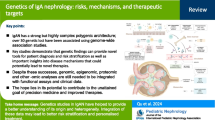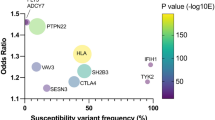Abstract
Background
Familial hypomagnesemia with hypercalciuria and nephrocalcinosis (FHHNC) is an autosomal recessive tubular disease caused by mutations in the CLDN16 or CLDN19 gene. Previous studies using microsatellite markers flanking the CLDN19 locus estimated that p.G20D (c.59G>A), a recurrent mutation in Spanish families, is a founder mutation. In the present study, we assessed the haplotype of Spanish patients using single nucleotide polymorphisms (SNPs).
Methods
Twenty-seven FHHNC patients were included in this study. We analyzed four SNPs located in CLDN19 introns 3 and 4 by polymerase chain reaction amplification and DNA sequencing.
Results
Three new patients with homozygous p.G20D were identified. The SNP genotyping analysis showed that alleles carrying this mutation shared a common SNP haplotype.
Conclusions
Our findings suggest the existence of a founder effect responsible for FHHNC in our cohort. Testing for the presence of mutation p.G20D should be the first genetic screening in Spanish patients.
Similar content being viewed by others
References
Praga M, Vara J, González-Parra E, Andrés A, Alamo C, Araque A, et al. Familial hypomagnesemia with hypercalciuria and nephrocalcinosis. Kidney Int 1995;47:1419–1425.
Knoers NV. Inherited forms of renal hypomagnesemia: an update. Pediatr Nephrol 2009;24:697–705.
Rodríguez-Soriano J, Vallo A, García-Fuentes M. Hypomagnesaemia of hereditary renal origin. Pediatr Nephrol 1987;1:465–472.
Benigno V, Canonica CS, Bettinelli A, von Vigier RO, Truttmann AC, Bianchetti MG. Hypomagnesaemia-hypercalciurianephrocalcinosis: a report of nine cases and a review. Nephrol Dial Transplant 2000;15:605–610.
Weber S, Schneider L, Peters M, Misselwitz J, Rönnefarth G, Böswald M, et al. Novel paracellin-1 mutations in 25 families with familial hypomagnesemia with hypercalciuria and nephrocalcinosis. J Am Soc Nephrol 2001;12:1872–1881.
Blanchard A, Jeunemaitre X, Coudol P, Dechaux M, Froissart M, May A, et al. Paracellin-1 is critical for magnesium and calcium reabsorption in the human thick ascending limb of Henle. Kidney Int 2001;59:2206–2015.
Konrad M, Schaller A, Seelow D, Pandey AV, Waldegger S, Lesslauer A, et al. Mutations in the tight-junction gene claudin 19 (CLDN19) are associated with renal magnesium wasting, renal failure, and severe ocular involvement. Am J Hum Genet 2006;79:949–957.
Simon DB, Lu Y, Choate KA, Velazquez H, Al-Sabban E, Praga M, et al. Paracellin-1, a renal tight junction protein required for paracellular Mg2+ resorption. Science 1999;285:103–106.
Faguer S, Chauveau D, Cintas P, Tack I, Cointault O, Rostaing L, et al. Renal, ocular, and neuromuscular involvements in patients with CLDN19 mutations. Clin J Am Soc Nephrol 2011;6:355–360.
Godron A, Harambat J, Boccio V, Mensire A, May A, Rigothier C, et al. Familial hypomagnesemia with hypercalciuria and nephrocalcinosis: phenotype-genotype correlation and outcome in 32 patients with CLDN16 or CLDN19 mutations. Clin J Am Soc Nephrol 2012;7:801–809.
Claverie-Martín F, García-Nieto V, Loris C, Ariceta G, Nadal I, Espinosa L, et al. Claudin-19 mutations and clinical phenotype in Spanish patients with familial hypomagnesemia with hypercalciuria and nephrocalcinosis. PLoS One 2013;8: 53151.
Hou J, Renigunta A, Konrad M, Gomes AS, Schneeberger EE, Paul DL, et al. Claudin-16 and claudin-19 interact and form a cation-selective tight junction complex. J Clin Invest 2008;118:619–628.
Hou J, Rajagopal M, Yu AS. Claudins and the kidney. Annu Rev Physiol 2013;75:479–501.
Hou J, Renigunta A, Gomes AS, Hou M, Paul DL, Waldegger S, et al. Claudin-16 and claudin-19 interaction is required for their assembly into tight junctions and for renal reabsorption of magnesium. Proc Natl Acad Sci U S A 2009;106:15350–15355.
Müller D, Kausalya PJ, Claverie-Martin F, Meij IC, Eggert P, Garcia-Nieto V, et al. A novel claudin 16 mutation associated with childhood hypercalciuria abolishes binding to ZO-1 and results in lysosomal mistargeting. Am J Hum Genet 2003;73:1293–1301.
Author information
Authors and Affiliations
Corresponding author
Rights and permissions
About this article
Cite this article
Martin-Nuñez, E., Cordoba-Lanus, E., Gonzalez-Acosta, H. et al. Haplotype analysis of CLDN19 single nucleotide polymorphisms in Spanish patients with familial hypomagnesemia with hypercalciuria and nephrocalcinosis. World J Pediatr 11, 272–275 (2015). https://doi.org/10.1007/s12519-014-0528-3
Received:
Accepted:
Published:
Issue Date:
DOI: https://doi.org/10.1007/s12519-014-0528-3




